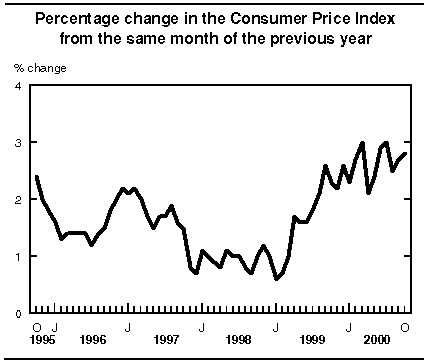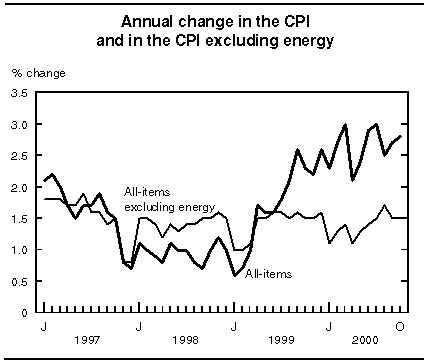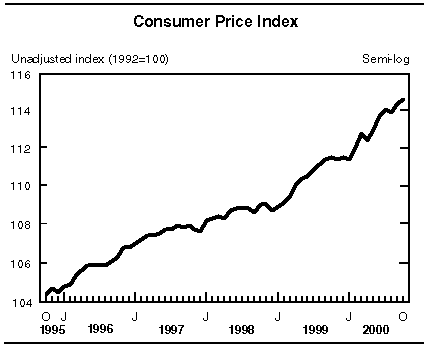 View the most recent version.
View the most recent version.Information identified as archived is provided for reference, research or recordkeeping purposes. It is not subject to the Government of Canada Web Standards and has not been altered or updated since it was archived. Please "contact us" to request a format other than those available.

The Daily. Tuesday, November 21, 2000
Consumers paid 2.8% more in October than they did in October 1999 for the goods and services contained in the Consumer Price Index (CPI) basket. This year-over-year increase was slightly larger than the 2.7% rise in September. Higher energy prices, prevalent since April 1999, were still the major contributor to the increase in the All-items CPI in October, accounting for almost half of the rise. Excluding the effect of higher energy prices, the All-items CPI advanced by 1.5% between October 1999 and October 2000. This increase falls within the range of 1.1% to 1.7% seen since March 1999.

Energy prices have edged up, on average, by 15.2% between October 1999 and October 2000. More than half of this increase can be attributed to higher gasoline prices (+16.2%). Higher prices for natural gas (+31.8%) and fuel oil (+42.1%) also contributed to the energy index increase.
Higher mortgage interest cost, higher prices for restaurant food and telephone services and higher rents were among the other factors contributing to the annual increase in the All-items CPI in October. However, the indexes for the purchase of automotive vehicles, computer equipment and supplies, and child care exerted some downward pressure on the CPI.

Changes in property taxes, including school taxes and special charges, are reflected in the CPI once a year, in the October index. The index rose by 0.4% it fell 0.5% in October 1999. Increases were widespread this year; only Manitoba, Quebec, Whitehorse and Yellowknife registered declines. Property owners in Nova Scotia saw the biggest increase, 3.2%, mainly because of higher assessment values. Prince Edward Island posted the smallest property tax rise, 0.2%. In Manitoba, an increase in the provincial rebate was the main cause for the 2.7% overall decline in property taxes. The indexes for Whitehorse and Yellowknife dropped 1.5%, while the index for Quebec fell by 0.4%.
The CPI edged up by 0.2% in October from September. This monthly increase is slightly smaller than the 0.4% advance in September. For the second consecutive month, the All-items excluding energy index remained unchanged. Among the energy components, natural gas and fuel oil had the greatest impact. Higher prices for automotive insurance premiums, men's clothing and homeowners' maintenance and repairs also put upward pressure on the All-items CPI; exerting downward pressure were lower prices for traveller accommodation, air transportation, gasoline and women's clothing.
Natural gas prices increased, on average, by 10.8% from September to October. Most of that impact came from a 17.3% rise in Ontario. Alberta (+9.3%), Quebec (+8.8%), and Manitoba (+1.3%) also recorded monthly increases. Prices remained stable in Saskatchewan and British Columbia.
Fuel oil prices rose by 3.1% from September to October, following a rise of 16.0% from August to September. Yellowknife registered the largest monthly rise, 4.9%; Saskatchewan and Alberta saw the smallest increase, 1.2%.
The index for automotive insurance premiums advanced 1.5% in October. This was owing to rate increases in Ontario (+1.0%) and, in British Columbia (+6.7%), to increases by the Insurance Corporation of British Columbia.
The index for men's clothing rose by 2.4% in October, partly the result of the introduction of fall seasonal items.
The index for homeowners' maintenance and repairs rose by 1.7% from September to October, due mostly to increases in material costs.
With the arrival of the off-peak tourism season, prices for traveller accommodation decreased by 6.3%. The decline was larger than September's drop of 2.4%. All provincial indexes dropped in October, Alberta's (-18.6%) the most and Quebec's (-1.1%) the least.
The air transportation index decreased by 6.7% from September to October. This partly because of seat sales on select domestic and transatlantic routes.
Gasoline prices edged down by 0.7% nationally. The decline is due mainly to competitive pricing in Ontario (-2.2%) and Manitoba (-2.5%). Price decreases were also recorded in Quebec (-0.2%) and Newfoundland (-0.3%). All other provinces recorded increases ranging from 0.5% in Yellowknife to 2.5% in Prince Edward Island.
The women's clothing index decreased by 1.5% from September to October, owing mainly to sale pricing on a broad variety of clothing items.

Available on CANSIM: matrices 9940-9956.
Available at 7 a.m. on Ststistics Canada's Web site (www.statcan.ca).
The October 2000 issue of the Consumer Price Index (62-001-XPB, $11/$103) is now available. See How to order products.
November's Consumer Price Index will be released on December 14.
For more information, or to enquire about the concepts, methods or data quality of this release, contact (613-951-9606; fax: 613-951-1539; infounit@statcan.gc.ca), Prices Division.
Consumer Price Index and major components
1992=100
| Oct. 2000 | Sept. 2000 | Oct. 1999 | Sept. to Oct. 2000 | Oct. 1999 to Oct. 2000 | |
|---|---|---|---|---|---|
| not seasonally adjusted | |||||
| % change | |||||
| All-items | 114.6 | 114.4 | 111.5 | 0.2 | 2.8 |
| Food | 112.0 | 112.2 | 109.9 | -0.2 | 1.9 |
| Shelter | 110.6 | 109.6 | 105.8 | 0.9 | 4.5 |
| Household operations and furnishings | 110.7 | 110.5 | 109.6 | 0.2 | 1.0 |
| Clothing and footwear | 107.5 | 107.4 | 107.3 | 0.1 | 0.2 |
| Transportation | 131.5 | 131.9 | 127.1 | -0.3 | 3.5 |
| Health and personal care | 112.8 | 112.3 | 110.6 | 0.4 | 2.0 |
| Recreation, education and reading | 124.4 | 124.9 | 122.0 | -0.4 | 2.0 |
| Alcoholic beverages and tobacco products | 98.1 | 98.4 | 94.6 | -0.3 | 3.7 |
| Goods | 112.1 | 111.8 | 108.8 | 0.3 | 3.0 |
| Services | 117.5 | 117.4 | 114.7 | 0.1 | 2.4 |
| All-items excluding food and energy | 112.9 | 112.8 | 111.2 | 0.1 | 1.5 |
| Energy | 134.6 | 132.8 | 116.8 | 1.4 | 15.2 |
| Purchasing power of the consumer dollar expressed in cents, compared to 1992 | 87.3 | 87.4 | 89.7 | ||
| All-items (1986=100) | 146.8 | ||||
Consumer Price Index for the provinces, Whitehorse and Yellowknife
1992=100
| Oct. 2000 | Sept. 2000 | Oct. 1999 | Sept. to Oct. 2000 | Oct. 1999 to Oct. 2000 | |
|---|---|---|---|---|---|
| not seasonally adjusted | |||||
| % change | |||||
| Newfoundland | 114.2 | 114.0 | 110.9 | 0.2 | 3.0 |
| Prince Edward Island | 113.3 | 112.9 | 108.4 | 0.4 | 4.5 |
| Nova Scotia | 115.4 | 115.0 | 111.7 | 0.3 | 3.3 |
| New Brunswick | 113.9 | 113.7 | 110.4 | 0.2 | 3.2 |
| Quebec | 111.5 | 111.4 | 109.0 | 0.1 | 2.3 |
| Ontario | 115.2 | 114.9 | 111.9 | 0.3 | 2.9 |
| Manitoba | 118.8 | 119.0 | 116.2 | -0.2 | 2.2 |
| Saskatchewan | 117.5 | 117.5 | 114.3 | 0.0 | 2.8 |
| Alberta | 119.2 | 119.1 | 115.1 | 0.1 | 3.6 |
| British Columbia | 114.5 | 114.3 | 111.8 | 0.2 | 2.4 |
| Whitehorse | 115.1 | 115.8 | 112.9 | -0.6 | 1.9 |
| Yellowknife | 111.5 | 112.0 | 110.1 | -0.4 | 1.3 |